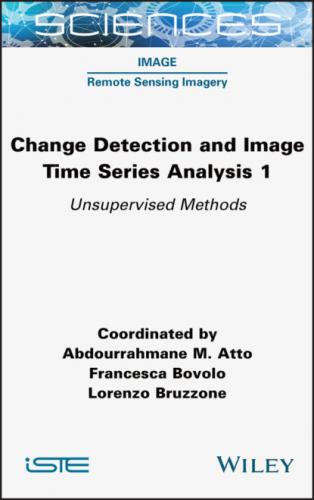1.4. Dataset description and experimental setup
1.4.1. Dataset description
The first dataset is a pair of QuickBird images acquired over an urban area in Xuzhou city, Jiangsu province (China) in September 2004 (X1) and May 2005 (X2), respectively. The Gram–Schmidt (G-S) pan-sharpening algorithm was applied to fuse the multispectral (2.4 m) and panchromatic images (0.6 m), in order to generate the final fused dataset (0.6 m) with four spectral bands (i.e. red, green, blue and near infrared). Images were radiometrically corrected and co-registered (with residual misregistration of about 0.3 pixels), and the final region with a size of 760×370 pixels was extracted for the CD experiment. A total of six change classes are presented in this scenario. Detailed class transitions are: 1) soil to built-up area (C1); 2) soil to roof (face to the sun) (C2); 3) soil to roof (back to the sun) (C3); 4) built-up area to soil (C4); 5) shadow to soil (C5); 6) trees to soil (C6). The false color composite images X1 and X2 are shown in Figure 1.6 (a) and (b), respectively, and Figure 1.6 (c) presents the change reference map made by careful image interpretation.
Figure 1.5. Illustration of the decision-level fusion-based binary CD step. For a color version of this figure, see www.iste.co.uk/atto/change1.zip
Figure 1.6. Color-infrared composite of bitemporal QuickBird pan-sharpened images (bands 4, 3, 2) over an urban area in Xuzhou city, acquired in (a) 2004 (X1) and (b) 2005 (X2). (c) Change reference map. For a color version of this figure, see www.iste.co.uk/atto/change1.zip
Figure 1.7. False color composite of QuickBird images of the Indonesia tsunami dataset acquired in: (a) April 2004 (before tsunami), (b) January 2005 (after tsunami); (c) and (d) are two subsets selected from the whole scene in the qualitative experimental analysis. (e) Change reference samples. For a color version of this figure, see www.iste.co.uk/atto/change1.zip
The second dataset is made up of a pair of co-registered QuickBird multispectral images with a spatial resolution of 2.4 m, acquired over a large coastal area in Indonesia in April 2004 and January 2005, respectively (see the two times of the false color composite images shown in Figure 1.7(a) and (b), respectively). The whole study area considered has a size of 3,250×4,350 pixels. Two subsets were selected for detailed qualitative analysis, as shown in Figure 1.7(c) and (d). A change reference sample map was made by careful image interpretation (Figure 1.7(e)). The changes that occurred in this scene were mainly caused by the tsunami in December 2004, which include the following classes: (1) vegetation to flooded district (C1); (2) forest to flooded district (C2); (3) shadow to vegetation (C3); (4) shadow to forest (C4); (5) bareland to flooded district (C5); (6) cloud to forest (C6); (7) forest to shadow (C7).
1.4.2. Experimental setup
For comparison purposes, CD results obtained by the proposed M2C2VA and SPC2VA approaches were compared with two state-of-the-art unsupervised multiclass CD techniques, including the iteratively reweighted multivariate alteration detection (IR-MAD) (Nielsen 2007), and the sequential spectral change vector analysis (S2CVA) (Liu et al. 2015). Note that M2C2VA and SPC2VA considered both spectral and spatial change information, whereas IR-MAD and S2CVA considered only the spectral change information. Detailed quantitative and qualitative analyses were conducted according to the obtained CD accuracy, i.e. OA and Kappa, and error indices, i.e. omission errors (OE), commission errors (CE), total errors (TE), and the obtained CD maps. In addition, the computational cost was also considered in each method and compared. All of the experiments were conducted using MATLAB R2016b, on an Intel (R) Core (TM) i7-6700 CPU @ 3.40GHz PC with 32 GB of RAM.
Figure 1.8. 2D compressed change representation in the polar domain (Xuzhou dataset). For a color version of this figure, see www.iste.co.uk/atto/change1.zip
Figure 1.9. Determination of the optimal segmentation scale in the Xuzhou dataset. (a) GE values of different segmented scales; (b) logarithmic fitting results based on (a). For a color version of this figure, see www.iste.co.uk/atto/change1.zip
1.5. Results and discussion
1.5.1. Results on the Xuzhou dataset
The 2D compressed change representation in the polar domain is shown in Figure 1.8, where six change clusters can be observed, indicating different change directions. Then, K = 6 is fixed in the considered CD methods for performing the multiclass CD.
The optimal segmentation scale was estimated by analyzing the GE values (see Figure 1.9(a)) and its logarithmic fitting results (see Figure 1.9(b)). The TGE was calculated and defined as 1 × 10−4, then the final segmentation optimal scale was obtained as 1,160.
From the detailed quantitative and
